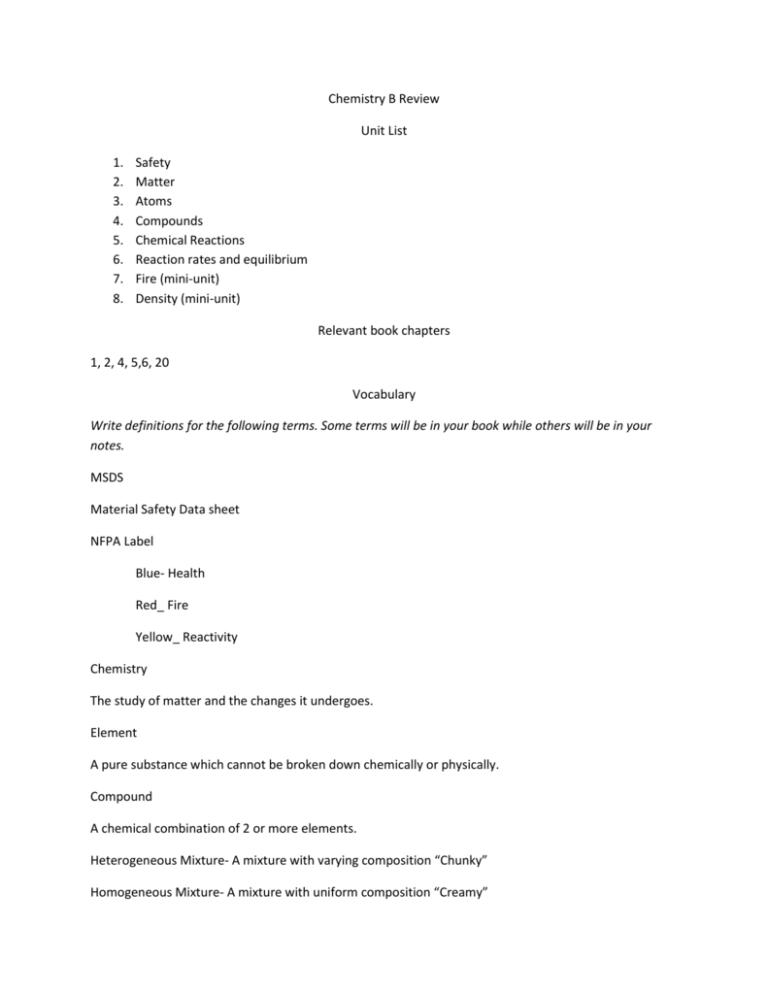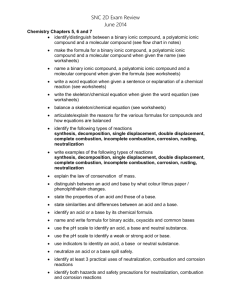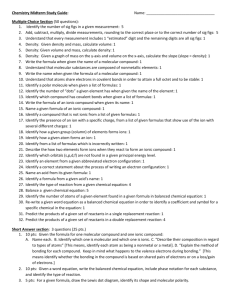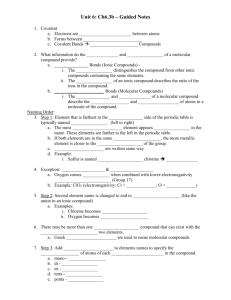Chemistry B Review
advertisement

Chemistry B Review Unit List 1. 2. 3. 4. 5. 6. 7. 8. Safety Matter Atoms Compounds Chemical Reactions Reaction rates and equilibrium Fire (mini-unit) Density (mini-unit) Relevant book chapters 1, 2, 4, 5,6, 20 Vocabulary Write definitions for the following terms. Some terms will be in your book while others will be in your notes. MSDS Material Safety Data sheet NFPA Label Blue- Health Red_ Fire Yellow_ Reactivity Chemistry The study of matter and the changes it undergoes. Element A pure substance which cannot be broken down chemically or physically. Compound A chemical combination of 2 or more elements. Heterogeneous Mixture- A mixture with varying composition “Chunky” Homogeneous Mixture- A mixture with uniform composition “Creamy” Pure Substance Substance which can’t be broken down physically. Physical Change Change in the shape or appearance of matter without changing the molecules. Chemical Change Change in the structure of the molecules of a substance. Physical Property Property relating to physical changes Chemical Property Property relating to chemical changes. Reaction Indicators 1. Heat/Light 2. New Gas 3. Precipitate Atom Smallest piece of an element there is. Molecule Multiple atoms attached by chemical bonds. Proton Positively charged subatomic particle found in the nucleus Neutron Neutral particle found in the nucleus Electron Negatively charged particle found in the electron cloud. Nucleus Positvely charged core of an atom which contains most of the mass of the atom and is positively charged Ionic Compound A cation and anion held together by their electrical attraction for each other. Acid A compound containing hydrogen and an anion. Molecular compound A compound containing non-metals Chemical Reaction Atoms break their bonds and reconnect to form new molecules Reactant Starting materials for a chemical reaction Product Ending materials produced by a chemical reaction. Composition (also called combination or synthesis) Two substances combine to make a new one. A + X AX Decomposition A compound breaks apart into more than one. AX A + X Single Replacement (also called single displacement) A single element replaces an element in a compound. AX + B A + BX Double Replacement (also called double displacement) Two compounds swap ions. AX + BY AY + BX Combustion Oxygen and a hydrocarbon produce carbon dioxide and water. Reaction Rate Catalyst Substance which increases reaction rate by decreasing activation energy Inhibitor Substance that decreases reaction rate by increasing activation energy Equilibrium Forward and reverse reaction rates balance each other out Exothermic Reaction that gives off energy (product) Endothermic Reaction that takes in energy (reactant) Activation Energy Energy needed to start a chemical reaction Calorimetry Using temperature changes in a water sample to calculate energy released by a chemical process. Smoke Parts 1. Carbon dioxide 2. Water vapor 3. Leftover hydrocarbons Reactants for Combustion 1.____Oxygen____________ and 2. _____Hydrocarbon______________ Products for Combustion 1. __Carbon dioxide___________ and 2. _______Water_____________ Convection Heat transferred by air currents Conduction_ Heat transfer by direct contact Radiation Heat transferred by electromagnetic waves (infrared) Premixed Flame Flame that has oxygen and fuel mixed before burning. More efficient and hotter. Diffusion Flame Flame that mixes fuel and oxygen as it burns. Less efficient and cooler. Hydrocarbon Compound containing carbon and hydrogen and sometimes oxygen. Density Mass divided by volume. Density Column Liquids of various densities in a cylinder with the most dense liquid on the bottom and the lowest density on top. Review Exercises Do the following problems to help prepare for the fill in the blank portion of the exam Matter review 1. a. b. c. d. e. f. Identify each of the following as element, compound or mixture Kool aid- mixture Iron- element Pure Water- compound River water-mixture Sodium Bicarbonate-compound Gasoline-mixture 2. For each process described below decide if it is a chemical or physical change a. b. c. d. e. Milk goes sour- chem Paper Burns-chem Paper is ripped-phys Ice melts-phys Pancakes cook-chem Compounds review FORMULA TYPE OF COMPOUND:IONIC, MOLECULAR OR IONIC NAME KBr Ionic Potassium Bromide SF6 Molecular Sulfur hexaflouride Cu2CO3 Ionic Copper (I) Carbonate P2O4 Molecular Diphosphorous Tetraoxide Al(NO3)3 Ionic Aluminum Nitrate HCl Acid Hydrochloric Acid H2SO4 Acid Sulfuric Acid Na3PO4 Ionic Sodium phosphate CaO Ionic Calcium Oxide IBr3 Molecular Iodine Tribromide K2Cr2O7 Ionic Potassium dichromate NH4Cl Ionic Ammonium Chloride NiCl2 Ionic Nickel (II) Chloride HNO2 Acid Nitrous Acid Fe2S3 Ionic Iron (III) Sulfide CoO Ionic Cobalt (II) Oxide Reactions Review A ______Single replacement____ reaction is one in which one lone element replaces an element that's in a compound. In a ___Combustion___ reaction the products are always carbon dioxide and water. A _Double Replacement_____ reaction involves two compounds switching elements with each other. Two reactants coming together to form one product is a _Composition___ reaction. One reactant breaking up into two products is a Decomposition_ reaction. The _Reactants__ are always on the left side of the arrow in a BCE __Exothermic______ reactions give off energy Balance the following and identify the reaction type. __1__CH4 + __2___O2 ---> ___1_CO2 + ___2_H2O ____1_Mg + ___2_HCl--> __1___MgCl2 + __1_H2 type___Combustion__________ type____SR___ ___3__PbSO4 + __2__FeCl3 ---> __1__Fe2(SO4)3 + ___3__PbCl2 type_______DR___ ___2__KClO3 --> _2__KCl + __3__O2 type____D_______ ___2__Mg + __1___O2 --> __2__MgO type______C_______ Reaction Rates and Equilibrium Review Look at the diagram below a What is the activation energy for this reaction? 7J What is the energy change for the reaction? 9J Is the reaction endothermic or exothermic. Exothermic Consider the reaction below: H2(g)+I2(g)→2HI(g) a. If H2 is removed to the system how will this affect the equilibrium? left b. If I2 is removed from the system how will this affect the equilibrium? left c. If HI is removed to the system how will this affect the equilibrium? right d. If the pressure is decreased how will this affect the equilibrium? No change Fire Review Write Balanced Chemical Equations for the following hydrocarbons 1. CH4 __1__CH4 + __2___O2 ---> ___1_CO2 + ___2_H2O type___Combustion__________ 2. C3H8 C3H8 + 5O2 3 CO2 + 4 H2O 3. C4H10 2C4H10 + 13O2 8 CO2 + 10 H2O Density Review 1. What determines where a layer will be a density column? Highest density on bottom, lowest on top 2. What is the equation for density? Mass divided by volume 3. What is the correct unit for mass g 4. A substance is 12.4g and takes up 16.7mL. What is the substance’s density? 0.74g/mL







